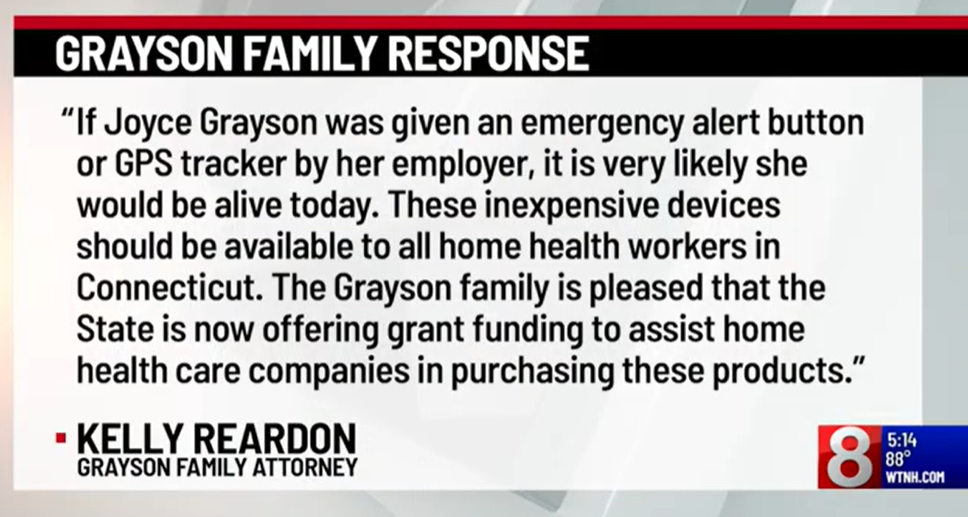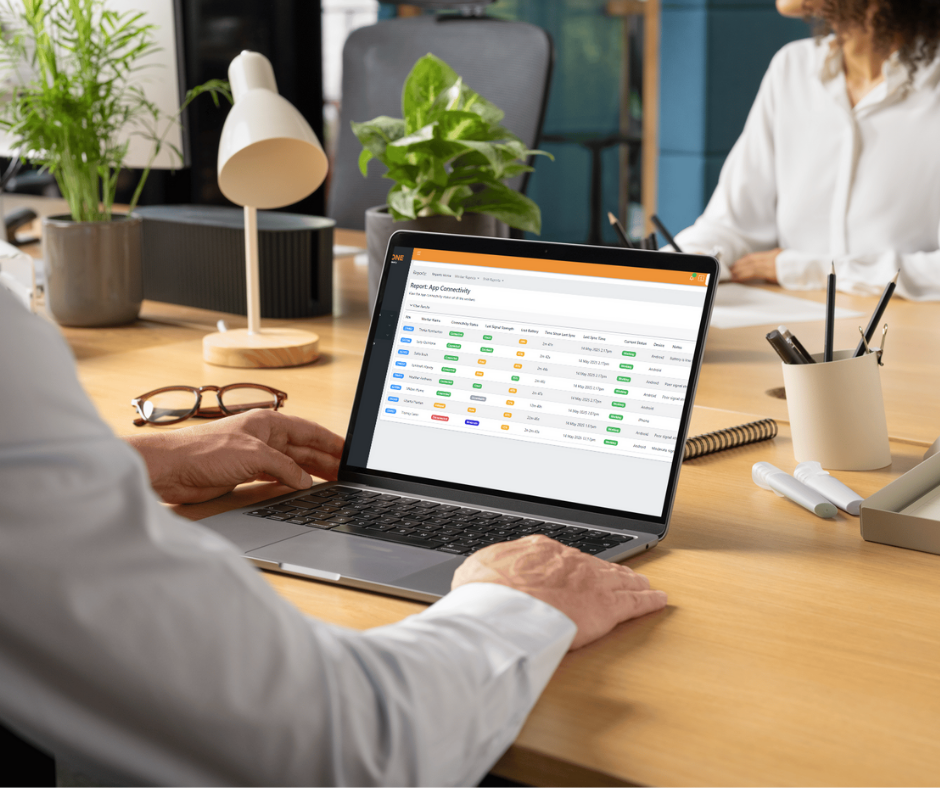Connecticut Launch New State Grant Program on Home Health Care Worker Safety

Introduction
In response to growing concerns about worker safety in the Connecticut home health sector, Governor Ned Lamont’s administration have introduced a new state grant program for home health care workers through Public Act No. 24-19. This new grant program is designed to support home health agencies by funding a range of safety improvements for their employees.
The healthcare sector is continuing to expand in Connecticut, and so too are the challenges faced by its workers. Among the most pressing issues is workplace violence, a serious concern that has been thoroughly researched by the Occupational Safety and Health Administration (OSHA). Between 2010 and 2017, OSHA conducted extensive studies across various industries in the United States, and the findings were alarming: the majority of workplace-related assaults occurred in healthcare and social service settings (OSHA, 2015). ¹ While media coverage often highlights workplace homicides, most violent incidents result in non-fatal, yet serious injuries.
Worrying Statistics
Data from the Bureau of Labor Statistics (BLS) further underscores this issue. Data collected from across the US between 2011 and 2013, shows workplace assaults ranged from 23,540 to 25,630 annually, with 70 to 74% occurring in healthcare and social services. For healthcare workers, assaults comprise 10-11% of workplace injuries involving days away from work, compared to just 3% for all private sector employees. ²
These figures paint a grim picture of the risks faced by healthcare workers, particularly in the previous decade. Moreover, research indicates that workplace violence is underreported, suggesting that the actual rates may be much higher.
Current BLS data shows that 3,504,230 people are employed as Home Health and Personal Care Aides, with the vast majority being 88% female, 29% Black or African American, and 19% Latino or Hispanic. ³ The high rates of workplace violence against these workers highlight the urgent need for organizations, communities, and policymakers to prioritize their safety and ensure they have sufficient protective measures in place, not just in Connecticut but across the country as a whole.

Connecticut State Funding Grant
As of May 2024, according to the state Department of Labor, one in eight Connecticut workers (218,900) were employed in the healthcare sector. Healthcare jobs are among the fastest growing in the state, with nurses representing the largest group, totalling 79,822 professionals. ⁴
To address the concerns of health care workers and their families, Public Act No. 24-19 was enacted under Governor Lamont’s administration. This program provides funding grants to home health workers in Connecticut to improve safety protocols and allow employers to purchase support services for their workers. The program covers a range of safety enhancements, including emergency alert buttons, buddy escort systems, tracking devices, safety training, risk-scoring tools, safety consultants, and the establishment of dedicated phone lines for staff in the field to access immediate support.
Governor Lamont emphasized the importance of this initiative, stating, “Ensuring the safety and well-being of both our home healthcare workers and the individuals they serve is a top priority for the state. This grant program is a significant step towards providing the necessary tools and training to protect workers who provide an invaluable service to our state, especially for those who are most vulnerable. I look forward to a continued collaboration with our community partners to maximize the impact of these resources and increase the safety of home healthcare workers.” ⁵
Lt. Governor Susan Bysiewicz added, “Prioritizing the safety of our caretakers took precedence this year. A disproportionate number of home healthcare workers are women and women of color who serve in our vulnerable communities every single day. It is important we provide safer environments and the training and skills necessary for them to do their jobs without personal risk.” ⁶
Social Services Commissioner Andrea Barton Reeves echoed these sentiments, noting, “By investing in these safety measures, we are not only protecting our dedicated healthcare workers but also ensuring that our clients receive the highest quality care in the safest possible environment.” ⁷
At a press conference announcing the new funding and discussing the working conditions of staff who do home visits State Senator Saud Anwar stated that "65% of them have been exposed to verbal abuse, 44% physical abuse and 6% sexual abuse, these are health care workers." ⁸ Clearly expressing his concern for those working in the field.
The press conference continued with Governor Lamont paying tribute to Joyce Grayson the home visiting nurse who was tragically killed last October in Willimantic Connecticut. A statement regarding the new funding for healthcare facilities was released by Kelly Reardon the Grayson family attorney,

(Click here to watch WTNH's coverage of the press conference) ⁹
Local funding
Home health and access agencies interested in applying for these grants could begin submitting applications to the Connecticut Department of Social Services starting August 7, 2024. The first round of grants is anticipated to be released by the end of October. This program is initially being supported by $6 million in funding allocated by the Connecticut General Assembly and Governor Lamont through the federal American Rescue Plan Act. ¹º
The act mandates that by January 1, 2025, the Commissioner of Social Services will establish a home health worker safety grant program, with the goal of providing incentive grants by January 1, 2027. These grants will help agencies implement safety measures such as escorts for staff conducting home visits and mechanisms for staff to perform safety checks. These checks may include mobile applications that allow staff to access safety information related to clients and methods for communicating with local police in emergencies. Additionally, wearable GPS-enabled devices may be provided to allow staff to contact local police by pressing a button. ¹¹
How to use the funding effectively
To effectively allocate the funding provided under Public Act 24-19 and ensure the safety of home healthcare workers, implementing an employee safety monitoring app is one of the most efficient solutions. Apps, like Ok Alone, can significantly aid in enhancing employee safety by providing real-time safety checks, emergency communication tools, and GPS-enabled location sharing, all within a single platform.
Care workers can combine regular check-ins, panic buttons, and worker-down features within an employee safety monitoring app. These apps can be downloaded directly to a smartphone, eliminating the need for staff to carry additional devices. Packed with safety features like GPS locations, discreet alerts, and timed activity check-ins, these apps provide an extra layer of protection for staff who need it most.
By investing in such technology, agencies can maximize the impact of the allocated funds, ensuring their employees have immediate access to support and protective measures while on duty. This approach enhances overall safety, making it the best use of resources to protect the health and well-being of those on the front lines of care.

Conclusion
Connecticut experienced a local tragedy and are responding with funding and legislation, however, this is not a localised problem, as shown by the findings of BLS and OHSA it is a country wide problem that needs a federal level solution.
As Connecticut's healthcare sector continues to grow, so does the need to address the escalating issue of workplace violence, particularly against home healthcare workers. The availability of these funds represents a significant step toward enhancing the safety of these essential workers through the use of innovative safety solutions.
By implementing advanced safety monitoring technologies, such as the Ok Alone app, agencies can effectively utilize the funding being made available to ensure that healthcare workers are protected while delivering critical services. This is necessary to create a safer and more supported environment for all healthcare professionals in Connecticut.
References
1 - Pg 4, Enforcement Procedures and Scheduling for occupational Exposure to Workplace violence
2 - Pg 2, Guidelines for Preventing workplace violence for Healthcare and Social Service Workers https://www.osha.gov/sites/default/files/publications/osha3148.pdf
3 - https://blogs.cdc.gov/niosh-science-blog/2021/09/02/hhc-violence/
4- https://www.cthealthexplained.org/healthcare-workforce/#:~:text=How%20many%20healthcare%20workers%20does%20Connecticut%20have%3F&text=As%20of%20May%202024%2C%20one,fastest%20growing%20in%20our%20state.
5,6,7,- Governor Lamont Announces Launch of New State Grant Program on Home Health Care Worker Safety (ct.gov)
10 Governor Lamont Announces Launch of New State Grant Program on Home Health Care Worker Safety (ct.gov)
11- https://www.cga.ct.gov/2024/ACT/PA/PDF/2024PA-00019-R00SB-00001-PA.PDF
Book a Demo Today
Alternatively, get a free trial of the app
Want to try OK Alone? Click the button below and enter your details. It's free and no credit card is required.





